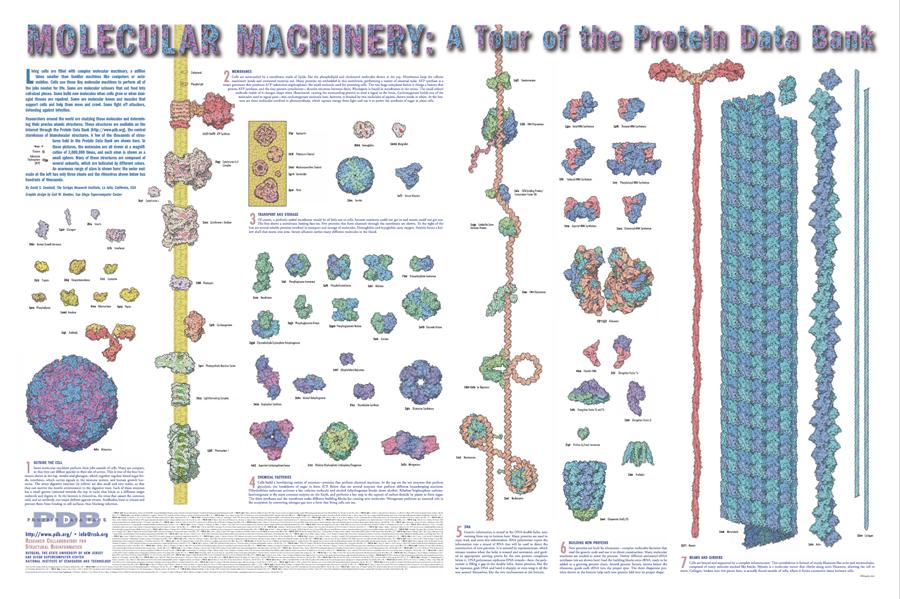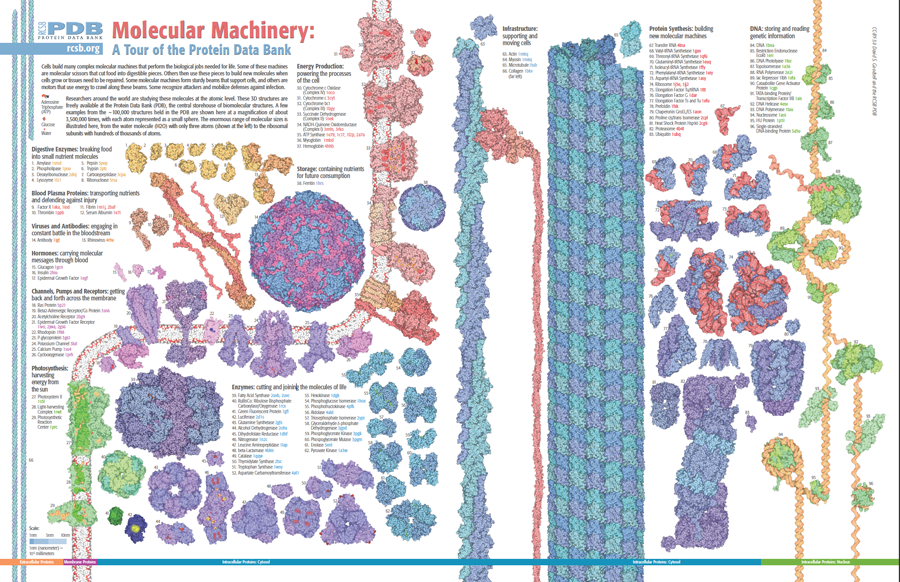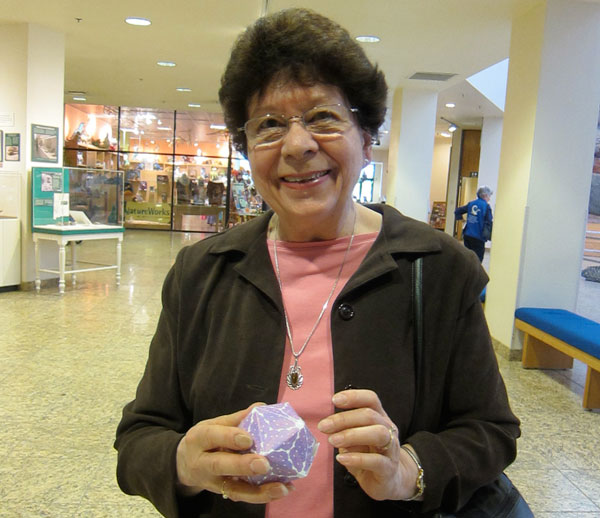
Original Molecular Machinery poster released in 2002. (Download PDF)

2014 version of the poster depicts 96 structures. (Download PDF)
In 2002, the RCSB PDB published the poster Molecular Machinery: A Tour of the Protein Data Bank. Created by Molecule of the Month creator David S. Goodsell, this illustration features 75 select structures from the PDB, showing their relative sizes at a scale of three million to one, and generally describes their critical roles in the functions of living cells. The image, available as a poster and handout, has been distributed to thousands of PDB users, teachers, and students over the years.
In celebration of the release of more than 100,000 structures in the PDB archive, Goodsell and RCSB PDB have updated this iconic image in a new Tour of the Protein Data Bank.
The 2014 poster uses 96 structures to illustrate the vast range of molecular shapes and sizes in the PDB. The structures are depicted relative to the cellular membrane and organized in categories related to function. A scale bar provides a sense of molecular size in nanometers.
The poster (PDF) is 34 x 22" and 23MB, and the double-sided flyer (PDF) is 8 1/2 x 11". Both the 2002 and 2014 posters are available for download from PDB-101.

See more images from the USA Science and Engineering Festival on our Facebook page.

Helen's thesis advisor GA Jeffrey, Ben Franklin, and Helen at the 1988 meeting of the American Crystallographic Association

One of the highlights of the ACA was a lecture presented by Dr. Doris Schattschneider on M.C. Escher and Crystallography. Schattschneider, shown here with the RCSB PDB's paper model of dengue virus, is the creator of the MC Escher Kaleiocycles.
Jasmine Young attended the 'The Seventh International Biocuration Conference (ISB2014)' at the University of Toronto in Toronto, Canada, from April 6-9, 2014 and presented a poster on The New Deposition & Annotation System that was a semifinalist in the competition for best poster.
At the USA Science & Engineering Festival (April 25-27 in Washington, DC), the RCSB PDB hosted a photo booth wall, distributed IYCr and RCSB PDB materials, and a molecular model building center that built ~600 DNA structures and close to 1000 viruses. The meeting was full of energy and activity, and we were excited to introduce so many families to the molecular world of the PDB. Visitors were very eager to learn about DNA and viruses, and asked many questions about structures in general.
On April 30, the RCSB PDB's Helen Berman was honored with the Benjamin Franklin Award from Bioinformatics.org at the 2014 Bio-IT World Conference & Expo for her work building the Protein Data Bank (PDB). The Franklin Award has recognized contributions to free and open science since 2002.
The RCSB PDB was pleased to be involved with several sessions and activities at the American Crystallographic Association (ACA)'s annual meeting in Albuquerque, NM from May 24-28.
As part of the Transactions Symposium: 100 Years of Crystallography, Helen gave a presentation on Databases in Crystallography: Past, Present, and Future, with a focus on the PDB, the Cambridge Crystallographic Data Centre, and The International Centre for Diffraction Data. A paper based on this talk will be published by the ACA.
Lead Biocurator Jasmine Young led two events: and the poster presentation of the New wwPDB Deposition and Annotation System and a dedicated Q&A session that included demonstrations of the deposition interface.
The RCSB PDB also met with users in the exhibit hall. Pictures from the meeting have been posted online.
Molecule of the Month creator David S. Goodsell made several presentations in Australia at the end of May, including at the Walter and Eliza Hall Institute of Medical Research in Melbourne and at the Museum of Contemporary Art in Sydney.
Also at the ACA meeting, the RCSB PDB Poster Prize was awarded to Kimberly Stanek for
Crystal structure and functional characterization of an Hfq homolog from Aquifex aeolicus (Kimberly Stanek, Jennifer Patterson, Peter Randolph, Cameron Mura; University of Virginia)
Many thanks to judges Esko Oksanen (European Spallation Source) and Michael Sawaya (UCLA), and to Marcia Colquhoun and the ACA.
All 2014 awardees will be listed on the RCSB PDB website and will receive an educational book.
A new and improved version of the RCSB PDB's exhibit was on display at Villejuif Bio Park and Sup'Biotech in Paris, France at the end of May. Pictures of the opening ceremony are online.
The Art of Science uses the context of an art exhibit to introduce audiences new and old to the beauty of the biomacromolecular structures and biology available in the PDB.
Since its beginnings in an art gallery at Rutgers University, the show has been hosted around the world including Texas A&M University, EMBL-Hamburg, Germany; University of Wisconsin-Madison; California State University, Fullerton; Purdue University; and Hyderabad, India. The exhibit toured mostly between 2002-2007, with a recent iteration in Egypt in 2013.
The current exhibit includes images from the original Art of Science show along with new works inspired by important Molecule of the Month topics, molecular artist Irving Geis, and the International Year of Crystallography.
This event was curated by Christine Zardecki and Maria Voigt (RCSB PDB) and coordinated in France by Julien Muzard (Conservatoire National des Arts et Metiers). Many thanks to Julien for his help!
Upcoming events for the Art of Science are scheduled for the end of 2014 at McPherson College in Kansas and at the Delbarton School in New Jersey. For additional details, please contact info@rcsb.org.
PDB-101 packages together resources that promote exploration in the world of proteins and nucleic acids for teachers, students, and the general public.
New features include a PDF that can be used to create a 3D model of Green Fluorescent Protein and a related Activity Page that includes background information on GFP, a video demonstrating how to create the GFP model, and a curated interactive molecular view.
Other resources include the Molecule of the Month articles on GFP and GFP-like Proteins, and a Bioinformatics of Green Fluorescent Protein tutorial guide.
One paper investigates how protein symmetry is linked to function and evolutionary processes, while another describes improvements made in the representation of peptide-like inhibitor and antibiotic molecules in the PDB.